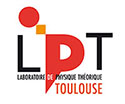Loading...
Présentation du LPT
Le LPT (UMR 5152, Laboratoire de Physique Théorique) est un laboratoire de recherche localisé sur le campus de l'Université Paul Sabatier de Toulouse. Il a été fondé en 1991 et a été créé administrativement en 2003. Les chercheurs du LPT étaient rattachés au Laboratoire de Physique Quantique au sein du Groupe de Physique Théorique. L'expertise du LPT couvre les domaines de la matière condensée et la matière molle ainsi que la physique statistique et la physique non-linéaire.
Le LPT est membre de la Fédération de recherche FeRMI (Fédération de recherche Matière et Interactions - FR2051), anciennement IRSAMC (Institut de Recherche sur les Systèmes Atomiques et Moléculaires Complexes).
Vous voulez-déposer un nouveau document ?
- Pas encore inscrit ? Inscrivez-vous
- Déposez une thèse : TEL (thèses en ligne)
- Documentation Hal
- Contact : documentation@irsamc.ups-tlse.fr
Les équipes de recherche
Consultez la politique des éditeurs en matière d'archivage
Derniers dépôts, tout type de documents
T-cell cytotoxic function relies on the cooperation between the highly specific but poorly adhesive T-cell receptor (TCR) and the integrin LFA-1. How LFA-1-mediated adhesion may scale with TCR stimulation strength is ill-defined. Here, we show that LFA-1 conformation activation scales with TCR stimulation to calibrate human T-cell cytotoxicity. Super-resolution microscopy analysis reveals that >1000 LFA-1 nanoclusters provide a discretized platform at the immunological synapse to translate TCR engagement and density of the LFA-1 ligand ICAM-1 into graded adhesion. Indeed, the number of high-affinity conformation LFA-1 nanoclusters increases as a function of TCR triggering strength. Blockade of LFA-1 conformational activation impairs adhesion to target cells and killing. However, it occurs at a lower TCR stimulation threshold than lytic granule exocytosis implying that it licenses, rather than directly controls, the killing decision. We conclude that the organization of LFA-1 into nanoclusters provides a calibrated system to adjust T-cell killing to the antigen stimulation strength.
The group symmetries inherent in quantum channels often make them tractable and applicable to various problems in quantum information theory. In this paper, we introduce natural probability distributions for covariant quantum channels. Specifically, this is achieved through the application of "twirling operations" on random quantum channels derived from the Stinespring representation that use Haar-distributed random isometries. We explore various types of group symmetries, including unitary and orthogonal covariance, hyperoctahedral covariance, diagonal orthogonal covariance (DOC), and analyze their properties related to quantum entanglement based on the model parameters. In particular, we discuss the threshold phenomenon for positive partial transpose and entanglement breaking properties, comparing thresholds among different classes of random covariant channels. Finally, we contribute to the PPT$^2$ conjecture by showing that the composition between two random DOC channels is generically entanglement breaking.
Topological insulators and superconductors support extended surface states protected against the otherwise localizing effects of static disorder. Specifically, in the Wigner-Dyson insulators belonging to the symmetry classes A, AI, and AII, a band of extended surface states is continuously connected to a likewise extended set of bulk states forming a “bridge” between different surfaces via the mechanism of spectral flow. In this work we show that this mechanism is absent in the majority of non-Wigner-Dyson topological superconductors and chiral topological insulators. In these systems, there is precisely one point with granted extended states, the center of the band, <math display="inline"><mi>E</mi><mo>=</mo><mn>0</mn></math>. Away from it, states are spatially localized, or can be made so by the addition of spatially local potentials. Considering the three-dimensional insulator in class AIII and winding number <math display="inline"><mi>ν</mi><mo>=</mo><mn>1</mn></math> as a paradigmatic case study, we discuss the physical principles behind this phenomenon, and its methodological and applied consequences. In particular, we show that low-energy Dirac approximations in the description of surface states can be treacherous in that they tend to conceal the localizability phenomenon. We also identify markers defined in terms of Berry curvature as measures for the degree of state localization in lattice models, and back our analytical predictions by extensive numerical simulations. A main conclusion of this work is that the surface phenomenology of non-Wigner-Dyson topological insulators is a lot richer than that of their Wigner-Dyson siblings, extreme limits being spectrumwide quantum critical delocalization of all states versus full localization except at the <math display="inline"><mi>E</mi><mo>=</mo><mn>0</mn></math> critical point. As part of our study we identify possible experimental signatures distinguishing between these different alternatives in transport or tunnel spectroscopy.
Chiral Spin Liquids (CSL) based on spin-1/2 fermionic Projected Entangled Pair States (fPEPS) are considered on the square lattice. First, fPEPS approximants of Gutzwiller-projected Chern insulators (GPCI) are investigated by Variational Monte Carlo (VMC) techniques on finite size tori. We show that such fPEPS of finite bond dimension can correctly capture the topological properties of the chiral spin liquid, as the exact GPCI, with the correct topological ground state degeneracy on the torus. Further, more general fPEPS are considered and optimized (on the infinite plane) to describe the CSL phase of a chiral frustrated Heisenberg antiferromagnet. The chiral modes are computed on the edge of a semi-infinite cylinder (of finite circumference) and shown to follow the predictions from Conformal Field Theory. In contrast to their bosonic analogs the (optimized) fPEPS do not suffer from the replication of the chiral edge mode in the odd topological sector.
Non-abelian symmetries are thought to be incompatible with many-body localization, but have been argued to produce in certain disordered systems a broad non-ergodic regime distinct from many-body localization. In this context, we present a numerical study of properties of highly-excited eigenstates of disordered chains with SU(3) symmetry. We find that while weakly disordered systems rapidly thermalize, strongly-disordered systems indeed exhibit non-thermal signatures over a large range of system sizes, similar to the one found in previously studied SU(2) systems. Our analysis is based on the spectral, entanglement, and thermalization properties of eigenstates obtained through large-scale exact diagonalization exploiting the full SU(3) symmetry.
